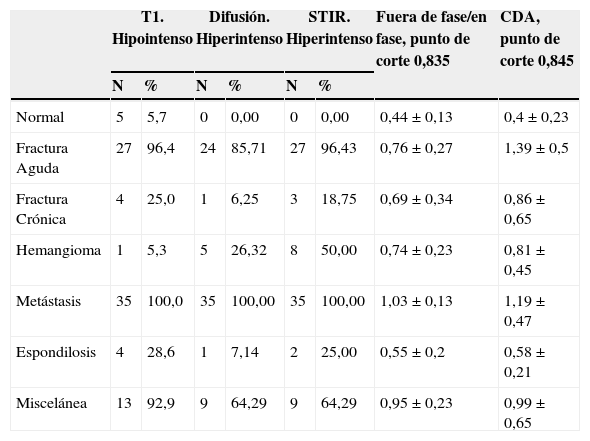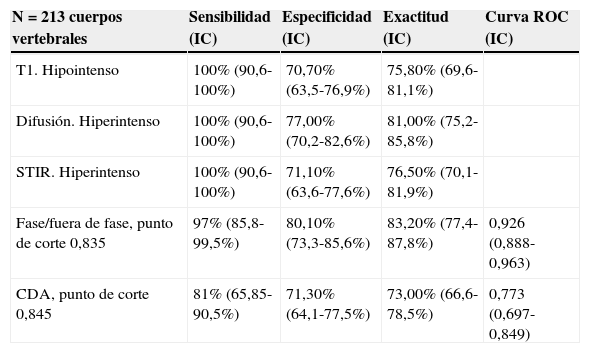Establecer la capacidad diagnóstica de la RM para distinguir las lesiones vertebrales benignas de las malignas.
Material y métodosIncluimos en el estudio a 85 pacientes con un total de 213 vértebras estudiadas (tanto patológicas como normales). Para cada vértebra determinamos si la lesión era hipointensa en T1 y si era hiperintensa o no en las secuencias STIR y potenciada en difusión. Calculamos el valor del cociente fuera de fase/en fase y el valor del coeficiente de difusión aparente de cada vértebra. A partir de los parámetros T1, difusión y STIR establecimos una combinación diagnóstica de lesión maligna.
ResultadosEl grupo comprendía 60 (70,6%) mujeres y 25 (29,4%) hombres con una edad media de 67±13,5 años (33-90 años). De los 85 pacientes, un total de 26 (30,6%) tenían antecedentes de tumor primario. Cuando la lesión era hipointensa en las imágenes potenciadas en T1, hiperintensa en STIR y en las imágenes potenciadas en difusión, y con un cociente de intensidad de señal mayor de 0,8, la sensibilidad fue del 97,2%; la especificidad del 90% y la exactitud diagnóstica del 91,2%. Si el paciente tenía un tumor primario conocido, los valores se incrementaron hasta el 97,2; 99,4 y 99%, respectivamente.
ConclusiónEs posible distinguir las lesiones benignas de las malignas si valoramos de forma conjunta la señal en T1, STIR y difusión y el cociente fuera de fase/en fase de la lesión detectada con RM en el cuerpo vertebral.
To determine the ability of MRI to distinguish between benign and malignant vertebral lesions.
Material and methodsWe included 85 patients and studied a total of 213 vertebrae (both pathologic and normal). For each vertebra, we determined whether the lesion was hypointense in T1-weighted sequences and whether it was hyperintense in STIR and in diffusion-weighted sequences. We calculated the in-phase/out-of-phase quotient and the apparent diffusion coefficient for each vertebra. We combined parameters from T1-weighted, diffusion-weighted, and STIR sequences to devise a formula to distinguish benign from malignant lesions.
ResultsThe group comprised 60 (70.6%) women and 25 (29.4%) men with a mean age of 67±13.5 years (range, 33-90 y). Of the 85 patients, 26 (30.6%) had a known primary tumor. When the lesion was hypointense on T1-weighted sequences, hyperintense on STIR and diffusion-weighted sequences, and had a signal intensity quotient greater than 0.8, the sensitivity was 97.2%, the specificity was 90%, and the diagnostic accuracy was 91.2%. If the patient had a known primary tumor, these values increased to 97.2%, 99.4%, and 99%, respectively.
ConclusionBenign lesions can be distinguished from malignant lesions if we combine the information from T1-weighted, STIR, and diffusion-weighted sequences together with the in-phase/out-of-phase quotient of the lesion detected in the vertebral body on MRI.
Artículo
Comprando el artículo el PDF del mismo podrá ser descargado
Precio 19,34 €
Comprar ahora














